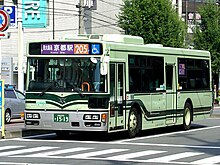Transport in Keihanshin


Transport in Greater Osaka is much like that of the Tokyo, includes public and private rail and highway networks; airports for international, domestic, and general aviation; buses; motorcycle delivery services, walking, bicycling, and commercial shipping. The nexus is in the central part of Osaka, though Kobe and Kyoto are major centers in their own right. Every part of Keihanshin has rail or road transport services. The sea and air transport is available from limited number of ports for general public.
Public transport within Greater Osaka is dominated by the world's 2nd most extensive urban rail network (only after Greater Tokyo), consisting of over 70 railway lines of clean and efficient surface trains and subways run by a variety of operators, with feeder buses, monorails, and trams playing a secondary role. More than 10 million people use the public transit system daily as their primary means of travel. Like Tokyo, walking and bicycling are much more common than in many cities around the globe. Private automobiles and motorcycles play a secondary role in urban transport.
Airports
Osaka Airport (Itami Airport) is the main domestic airport, and busiest, followed by Kansai International Airport, the main international airport in the region. Kansai Airport is the first airport in Japan to host scheduled international low cost carrier flights, and the first free (fare only) regularly scheduled, non-prize international flights to Japan.[1]
Kobe Airport is mostly domestic.
Yao Airport (In Osaka Prefecture)
Tokushima Airport is just outside the region.
There are also a number of military facilites.
Railway and subway

Railway in Greater Osaka is extremely dense, with primary rail riders hovering over ten million daily passengers. Railway usage and density is similar to that of Greater Tokyo, despite Greater Osaka's smaller size. Shinkansen also functions as commuter rail for nearby countryside as well as intercity and interregional rail.
- JR West
- JR Central
- Hanshin Electric Railway Main Line
- Hankai Tramway
- Hankyu Railway
- Keihan Electric Railway Keihan Main Line
- Kintetsu
- Nankai Electric Railway
- Kita-Osaka Kyuko Railway


- Kobe Electric Railway
- Sanyo Electric Railway
- Kobe Rapid Railway
- Keifuku Electric Railroad
- Nose Electric Railway
- Kobe New Transit
Category:Rail transport in Osaka Prefecture
Buses
Taxis
Taxis also serve a similar role to buses, supplementing the rail system, especially after midnight when most rail lines cease to operate. Persons moving around the city on business often chose taxis for convenience, as do people setting out in small groups.
Walking and cycling
Walking and cycling are very common forms of transport in Japan. Cycling shared 14% in whole Japan, 27% in the Netherlands, 18% in Denmark, 3% in France, 2% in United Kingdom, and 0.7% in United States. [2], and walking is very common as it goes hand in hand the rail system.
Scooters
Scooters, like in Tokyo was once quite popular in the nineties, have declined in popularity as people revert to using bicycles and walking. They are commonly used for buying groceries and short in town trips, as well as delivery of small items such as in food and household delivery services. Their decline is due to the fact that Japanese people prefer the exercise from walking/cycling, or the safety of a minicar.
Roads

Local roads
National, prefectural and metropolitan, and local roads crisscross the region.
Local and regional expressways
- Route 1
- Route 2
- Route 9
- Route 24 (Kyoto - Nara Prefecture - Wakayama Prefecture)
- Route 25 (Osaka - Nara - Nagoya)
- Route 26 (Osaka - Wakayama)
- Route 28 (Kobe - Awaji - Tokushima, Tokushima)
- Route 171 (Kobe - Kyoto , San'yōdō)
- Route 423 (Osaka - Senri - Kameoka , "New-Midosuji")
National
- Meishin Expressway (Asian Highway 1)
- Chūgoku Expressway (Asian Highway 1)
- Sanyō Expressway
- Kinki Expressway
- Maizuru Expressway ( To Maizuru )
- West-Meihan Expressway ( To Nara Prefecture,Nagoya )
- Hanwa Expressway ( To Wakayama Prefecture )
- Hanshin Expressway
Japan is now focusing on a nationwide expressway system. However, because of high tolls, expressways are prohibitively expensive for basic transport.
Shipping

Shipping plays the crucial role for the freight coming in and out of the area nationally and internationally, and Osaka areas exports and imported raw materials span the globe. Osaka's international ferry connections are far greater than Tokyo's, mostly due to geography. There are international ferries that leave Osaka for Shanghai, Korea, and until recently Taiwan. Osaka's domestic ferry services include regular service to ports such as Shimonoseki, Kagoshima, and Okinawa.
- Port of Osaka
- Port of Kobe
- Port of Sakai-Senboku (In Osaka Prefecture)
- Port of Himeji
